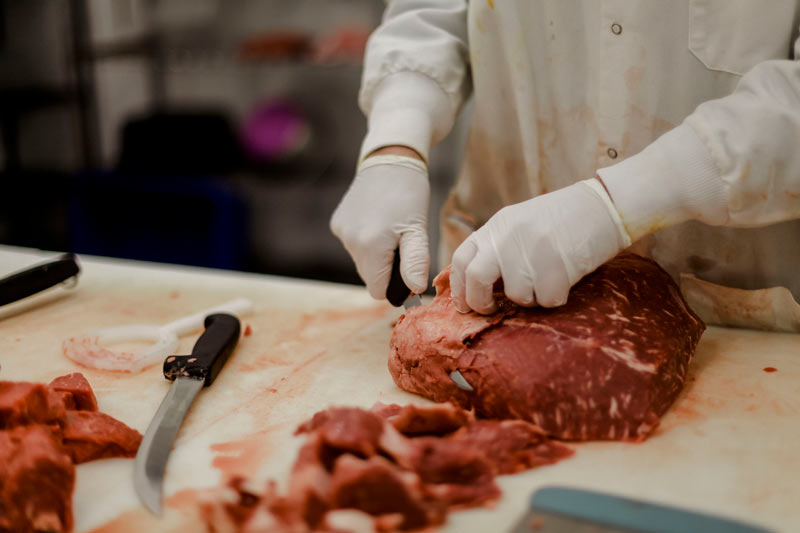Bagley Farms Meat Market Edwardsville IL: Your Relied On Resource for High-Quality Meats
Bagley Farms Meat Market Edwardsville IL: Your Relied On Resource for High-Quality Meats
Blog Article
Discover the Art of the Butcher's Cut in a Modern Meat Market
In the ever-evolving landscape of modern meat markets, the butcher's cut has actually transcended its standard origins, combining age-old craftsmanship with contemporary techniques. What truly sets the modern-day butcher apart is their capacity to build a much deeper connection in between customers and the beginnings of their meat.
Advancement of Butchery Strategies
The advancement of butchery techniques shows a rich tapestry of advancement and adaptation driven by advancements in technology, adjustments in consumer demand, and a deeper understanding of meat science. Historically, butchery was a craft gave with generations, with approaches sharpened over centuries to make best use of return and flavor. The commercial change ushered in mechanization, transforming conventional techniques and enabling large processing.
The mid-20th century saw butchery methods further fine-tuned by clinical understandings into muscle mass biology and meat aging, improving both inflammation and preference. Advancements like vacuum packaging and refrigeration extended product shelf-life, permitting butchers to diversify offerings and boost top quality control. This duration also marked the surge of customized equipment, such as band saws and meat slicers, which raised precision and effectiveness in meat processing.

Electronic systems currently help in monitoring animal provenance and enhancing cuts to meet specific consumer choices. Furthermore, a revival in artisanal butchery has arised, blending standard skills with contemporary expertise to provide to customers seeking moral and lasting meat options.
Recognizing Meat Cuts
Understanding the complexities of meat cuts is vital for both butchers and customers seeking top quality and worth. For butchers, precise cuts mirror skill and regard for the craft, making sure minimal waste and ideal return.

Comprehending muscle make-up is crucial; muscular tissues made use of a lot more frequently by the pet have a tendency to be tougher and are best matched for slow-moving cooking approaches, while less-used muscles, like those located in the loin, are much more tender and perfect for grilling or roasting. Familiarity with these differences equips customers to make enlightened selections, improving their cooking ventures.
Picking Top Quality Meat
Choosing the appropriate meat includes greater than just selecting an aesthetically appealing item from the display. bagley farms meat market edwardsville il. The art of choosing high quality meat needs a critical eye and understanding of particular qualities that represent freshness and quality. To start with, take notice of the shade; beef ought to have a brilliant, cherry-red hue, while lamb should display a soft pink tone, and pork a light pink. This shows the meat is fresh and hasn't been exposed to oxygen for also lengthy.
Secondly, consider the marbling, which describes the white streaks of fat within the muscle mass. Proper marbling is a key sign of tenderness and taste, as it thaws throughout food preparation, improving the meat's juiciness. Remember, higher marbling typically associates with exceptional high quality cuts, such as USDA Prime.
Texture is an additional crucial element; meat must really feel solid to the touch, not slimy or excessively soft. Furthermore, be mindful of the scent. Fresh meat ought to have a tidy, neutral check that scent, devoid of any sour or repulsive odors.
Coupling Cuts With Cooking Methods

Alternatively, tougher cuts like brisket and chuck roast are rich in collagen, which breaks down into gelatin when prepared slowly. These cuts are excellent for braising or slow-moving roasting, permitting the meat to tenderize with time and establish deep, complicated tastes. Cuts such as brief ribs and pork shoulder get on well with slow-cooking techniques, where expanded cooking times transform their robust appearances into succulent recipes.
Lamb shanks and oxtail, which call for prolonged cooking to soften, are best prospects for cooking or slow-moving simmering. These methods coax out abundant, passionate flavors while keeping dampness. By understanding the unique features of each cut, chefs and home chefs alike can boost their culinary creations, guaranteeing each meal is both satisfying and memorable.
The Butcher's Function Today
Browsing the evolving landscape of the contemporary meat market, the butcher's duty today prolongs past plain preparation of cuts. Contemporary butchers are culinary artisans, teachers, and web link supporters for lasting practices. They link the void between the ranch and the fork by making sure moral sourcing, comprehending animal husbandry, and focusing on openness in the supply chain. This shift reflects the expanding consumer need for top quality over amount, where provenance and animal welfare are critical.
In addition to crafting exact cuts, butchers now involve straight with consumers, offering cooking suggestions and tailoring selections to fit specific needs and preferences. Their expertise in meat aging, marbling, and taste accounts equips consumers to make educated decisions, boosting their culinary experiences. This individualized solution exhibits the butcher's evolving function as a trusted consultant in the kitchen.
Furthermore, butchers are pivotal in lessening waste, using entire pets to produce varied products such as sausages and supplies. This detailed strategy not just appreciates the pet yet additionally aligns with modern sustainability objectives. In this way, the modern butcher personifies both practice and advancement, adapting to an ever-changing market while protecting the artistry and integrity of their craft.
Verdict
The modern butcher's craft delicately weaves conventional methods with modern-day developments, stressing sustainable techniques and ethical sourcing. Proficiency in comprehending diverse meat cuts and top quality indications empowers butchers to provide educated suggestions, aligning certain cuts with optimum food preparation techniques. This proficiency not only raises cooking experiences yet also enhances the link between customers and the origins of their explanation their food. By recognizing historic techniques while accepting modern needs, the butcher's role remains important in today's innovative meat market (bagley farms meat market edwardsville il).
Report this page